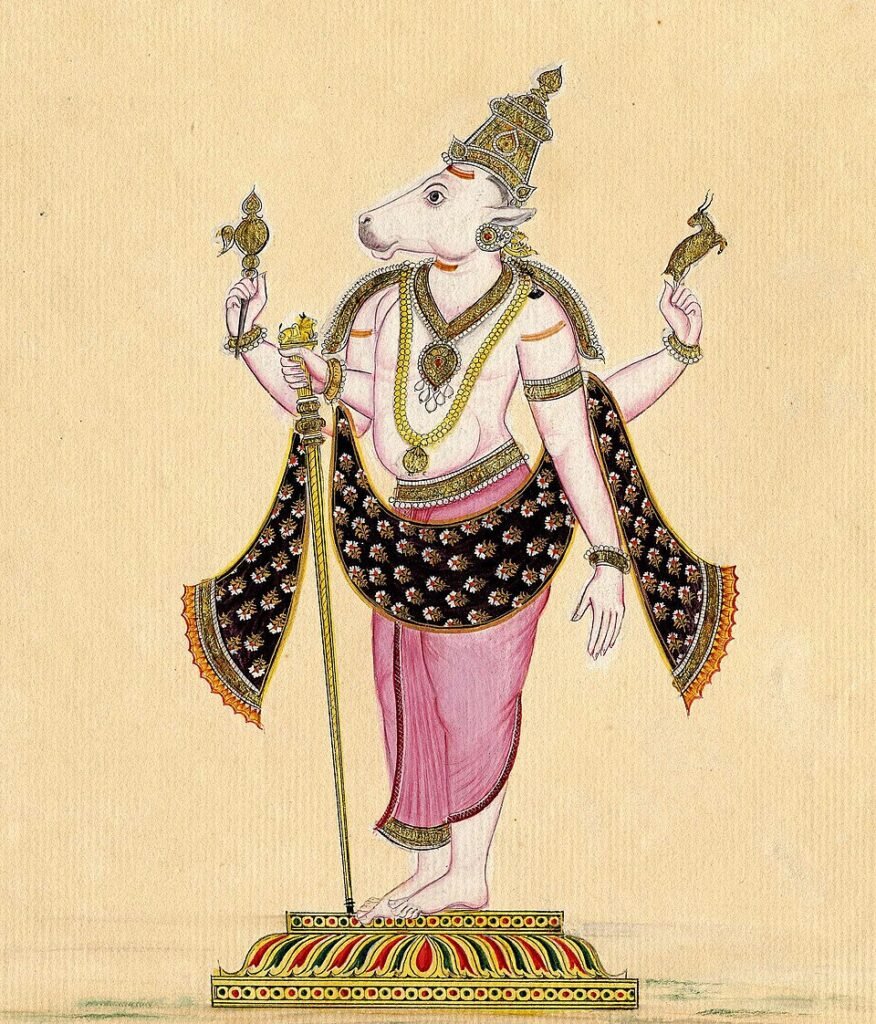
Although Sri Guru Bhagavan Dakshinamurti is revered as the first Siddha Purusha, the spiritual lineage is believed to have been initiated through Nandi Bhagavan. In the sacred traditions, Bhagavan remains the divine and Bhakta remains the devotee — a distinction that must be preserved with humility. Thus, from the perspective of the devotee, the spiritual journey is counted from Nandi Bhagavan.
It is said that eight people were directly initiated by Adi Guru Dakshinamurti through Mouna Upadesha (silent initiation). Among these, four were revered as “Nandis”, who are none other than the Sanakadi Maharishis. However, the Nandi Bhagavan we know does not belong to these four. His divine story begins separately — yet profoundly.
The Birth of Nandi: A Divine Boon Granted in Thiruvaiyaru
In the holy land of Thiruvaiyaru, in the Thanjavur district of Tamil Nadu, lived a mahayogi named Silata Muni and his virtuous wife Charuchanai, both yearning for a child. One day, the Saptarishis visited their ashram. Despite being invited for food, they declined, stating that the food were not to be accepted from households without progeny. Though not offended by their refusal, Silata Muni was deeply pained, reflecting on his own spiritual shortcomings.
(This is what sat-buddhi thinks! Not someone has done a prayoga on me, that is why I am into this problem; only when our people leave this side of journey, their true journey will begin. We will do our best to make a noise to ensure, won’t at least one will fall in the path with her grace.)
Getting back to Story: Moved by sorrow, Silata Muni bathed in the sacred Surya Pushkarani and undertook a deep penance, chanting the Shiva Panchakshari mantra with unwavering devotion. Pleased with his penance, Lord Shiva appeared before him and assured him of a divine son without death, one who would be equal in essence to Shiva himself, and gets worshipped wherever Shiva was worshipped.
The Divine Child Found in a Jewel-Encrusted Box
In those days, penances were not aided by the simplified / super simplified rituals. Yagna preparations required the land to be tilled by hand. While doing so, Silata Muni discovered a golden box adorned with Navaratnas (nine precious gems). Upon opening it, he beheld a radiant child with three eyes, resembling a rising sun, carrying a mazhu (axe) with a deer motif.
At that moment, an asareeri — a disembodied divine voice — was heard, commanding him to close the box immediately and reopen it. When obeyed, the child appeared transformed into a normal human form, still glowing with divinity. He was named Nandi.
The Tapasya That Granted Eternal Life for Nandi
When Nandi turned seven, two Deva Ganas, Mitrar and Varunar, visited the ashram. Upon looking at the Nandi, they informed Silata Maharishi that the child has a lifespan of only eight years. Silata Muni knew the truth that Nandi is Shiva himself in the essence who has an eternal life, But at the same time, the words of Deva Ganas cannot be ignored, so, he remained silent.
Upon hearing this, young Nandi sought his father’s blessings to perform penance to Sarveshwara (Lord Shiva) for the gift of longevity. With devotion blazing in his heart, he stood in the waters of Surya Pushkarani, hands raised in Namaskara Mudra, and completed eight crore japa mantras.
Moved by this unwavering devotion, Lord Shiva appeared once again and granted Nandi eternal life, taking him to Kailasha, where he would eternally serve at his side.
A Divine Marriage For Nandi Arranged by Shiva Himself
Now that Nandi’s life had been taken into the divine protection of the Lord, Shiva himself descended to find him a suitable bride. In Thirumazhapadi near Tiruchirapalli, a noble girl named Suyasai, the grand-daughter of Vashishta Maharishi, was chosen. Their divine marriage was performed at the Vaidyanatha Swamy Temple, attended by Deva Ganas and Rishi Munis alike.
Nandi’s Devotion: The Gateway to Shiva’s Abode
So immense was Nandi’s bhakti (devotion) that Lord Shiva declared in the Marriage hall –
“Those who wish to worship me must first worship Nandi. Only if Nandi is pleased shall their prayers reach me!”
This profound truth is the Tatparya (essence) — the Bhakta must always remain a Bhakta, and Swamy remains Swamy. While the Lord can descend to meet a devotee like Nandi, it is not for the devotee to rise above through ego, calling themselves Shiva’s son or daughter without living that dharmic life in truth.
If devotion is lived with earnestness and surrender, as shown by Nandi, the Lord shall come — just as He did for Nandi. But if modern, diluted philosophies are held on to — offering shallow comfort without depth — only the shells on the seashore will be found, not the pearl beneath the sea.Why Thirumular Called Nandi “Shivayoga Mamuni”
Perhaps it was this immeasurable bhakti and yogic stature that made Thirumular Siddhar himself refer to Nandi Bhagavan as “Shivayoga Mamuni”, meaning The Great Sage of Shiva Yoga.
There exists a sacred prayer to Nandi Bhagavan, to be recited by all Shiva devotees, seeking his permission to approach the sanctum of Shiva. Unless Nandi grants the way, entry into Shiva’s presence shall not be allowed.

